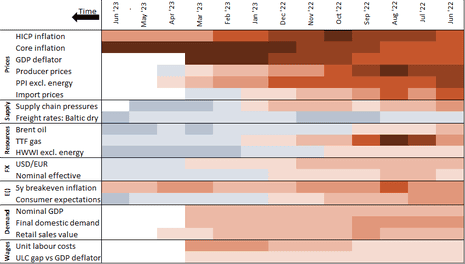Eurozone inflation drops to 5.5%
Newsflash: inflation across the eurozone has dropped again, and by more than expected, thanks to falling energy prices.
Consumer prices across the euro area rose by 5.5% in the year to June, down from 6.1% in May.
That’s lower than the 5.6% which economists expected, but still some way over the European Central Bank’s target of 2%.
Statistics provider Eurostat says that food, alcohol & tobacco is expected to have the highest annual inflation rate in June – at 11.7%, down from 12.5% in May.
Industrial goods inflation eased to 5.5%, from 5.8%.
But service sector inflation rose to 5.4%, up from 5.0% in May.
Energy prices fell at a faster rate than last month, with energy inflation dropping to -5.6% from -1.8% in May.
Core inflation, which strips out energy, food, alcohol & tobacco, rose to 5.4% from 5.3% (economists had expected a larger increase to 5.5%).
Key events
Headline PCE inflation slows to 3.8% in May vs 4.4% in April. That’s the lowest rate of inflation in over 2 years.
But core PCE slows only to 4.6% vs 4.7%, showing core price pressures to be much stickier.
In fact, gap between core and headline PCE now widest since Aug 2016. pic.twitter.com/7ttqy8mhAZ
— Jamie McGeever (@ReutersJamie) June 30, 2023
US PCE inflation rate eases
Over in the US, the Federal Reserve’s preferred inflation measure shows price pressures in America have eased.
The PCE price index rose by just 0.1% during May, and was 3.8% higher on an annual basis, down from 4.3% in the year to April. That fall could encourage Fed policymakers not to raise interest rates further, having left them on hold this month.
Core PCE, which exclude food and energy, rose by 0.3% during the month, but the annual rate dipped to 4.6% from 4.7%. That suggests underlying inflation may be more stubborn.
Core PCE monthly for May = 0.3%. That’s 0.1% point from being consistent with the Fed’s mandate.
0.2% x 12 = 2.4% — which is very close to the explicit 2% target.
— Steve Matthews (@SteveMatthews12) June 30, 2023
As regards PCE #inflation, the #Fed‘s preferred metric:
Headline rose 0.1% MoM and 3.8% on an annual basis, the lowest in 2 years and below the consensus forecast.
Core came in at 0.3% MoM and 4.6% YoY, pointing to relatively more stubborn price increases at this level.#economy…— Mohamed A. El-Erian (@elerianm) June 30, 2023
Andrew Hunter, deputy chief US economist at Capital Economics, says:
The PCE inflation data also provides some support for the doves at the Fed, with the headline PCE deflator rising by only 0.1% m/m, and the core index up by 0.3%, helped by a softer increase in services prices.
The eurozone will benefit from further disinflation this year, predicts Berenberg bank.
Following today’s drop in inflation, they predict CPI will drop below 3% by the end of the year, near to the 2% target.
Berenberg economist Salomon Fiedler says:
Eurozone inflation is now falling about as fast as it surged to its 10.6% peak in October 2022. In June, it dropped to 5.5% yoy, from 6.1% in May. Our Euro Inflation Monitor points to further disinflation over the remainder of 2023, with some month-to-month volatility.
The data indicate that core inflation will likely decelerate towards c4% by the end of 2023, while the headline figure should fall below 3% by that time. Our calls are roughly unchanged since our previous Euro Inflation Monitor one month ago.

Tesco has announced price cuts on more than 500 essential items, which could help nudge UK inflation down.
Tesco said it had cut the price of certain packs of own-brand pasta, tinned tuna, milk, grapes, cheese and other goods by an average of 13%, saying that it was working with its suppliers to pass on reductions where it could.
A 5 pence cut on fusilli pasta is the second in recent weeks, Tesco says, meaning shoppers will pay 20 pence less for a 500 gram pack than they would have paid in May.
A four-pint bottle of milk is also 10 pence cheaper, a second price cut in as many months.
This could strengthen hopes that the surge in grocery inflation will moderate this year (although supermarket are less vocal when they raise prices, so we’ll see…)
Tesco chief product officer Ashwin Prasad said:
“We know that more than ever our customers are looking for great value, and this huge round of price cuts on 500 key household essentials will help their budgets go a little further.
“With price cuts on products like grapes, peppers, rice and tuna, customers will find it’s even cheaper to eat healthily with Tesco this summer.
“And we’ll continue to work closely with our suppliers to pass on price cuts to our customers whenever we can.”
Here’s Labour’s shadow chancellor, Rachel Reeves, on this morning’s UK GDP National Accounts confirming growth of just 0.1% in Q4 2022 and Q1 2023.
ONS stats today show UK growth is still low and lagging behind competitors.
Despite Britain’s huge potential and promise the Tories are still taking us down a path of managed decline.
Labour will secure the highest sustained growth in the G7 so families are better off again.
— Rachel Reeves (@RachelReevesMP) June 30, 2023
Britain’s financial watchdog has updated its rulebook to allow mortgage lenders to help strugging customers.
Following last week’s meeting with chancellor Jeremy Hunt and UK banks, the Financial Conduct Authority has changed its rules to support the commitments made by lenders.
The changes mean that lenders will be able to offer borrowers, without an affordability check:
-
a switch to interest-only payments for 6 months
-
an extension to their mortgage term to reduce their monthly payments, with the option to switch back within 6 months
The FCA says:
The measures are designed to provide relief for people dealing with higher interest rates, but borrowers should be aware that making changes, even temporary ones, will very likely result in higher monthly payments in the future or paying back more overall.
Three eurozone countries have pulled their inflation rates below the ECB’s 2% target:
Britain’s competition regulator has got another technology deal in its sights.
The Competition and Markets Authority (CMA) has concluded that Adobe’s $20bn deal to acquire cloud-based designer platform Figma could mean less choice for designers of digital apps, websites and other products.
The CMA says its initial investigation into the deal has found Adobe’s purchase of Figma could reduce innovation.
Adobe has five working days to submit proposals to address the CMA’s concerns. Otherwise, the investigation will proceed to an in-depth phase 2 review.
The CMA found that Figma has established a substantial share of the market for screen design software and that Adobe has been continuously investing in and competing in this segment.
The CMA found that competition between Figma and Adobe has driven investment in updating and developing screen design software, and this important rivalry could be lost if the deal goes ahead.
“This morning’s data suggest that the Eurozone is on the path to bringing inflation down into more sustainable territory, report Sam Miley, senior economist at the CEBR thinktank:
Though the headline rate of price growth remains more than twice the ECB’s target, the fact that inflation has now slowed for two consecutive months and stands well below the recent peak of 10.6% will be welcomed by policymakers.
However, this is not sufficient for the central bank to halt its course of monetary tightening. Cebr expects the ECB to implement a further hike of 25 basis points to its key policy rates at its meeting next month, in an effort to put even further downward pressure on price growth in the medium term.” –
Home sales tumbled by a quarter in May compared with the same month a year earlier, new HM Revenue and Customs (HMRC) figures show today.
It’s another sign that the property market is cooling this year, as high borrowing costs hit demand.
HMRC reports that there were 74,360 residential transactions in May 2023 is 74,360, 25% lower than May 2022. But, that’s 10% higher more than in April 2023
HMRC say the annual fall “is partly due to higher number of bank holidays in May 2023, but also represents the decline in general market conditions in recent months”.
Andy Sommerville, director at property data and insight provider Search Acumen, says:
“Today’s figures show a continuation of the low transaction levels we have become accustomed to in 2023, with the property market facing significant challenges including rising inflation rates and the high cost of borrowing.
The downturn feels especially acute from the market recovery we witnessed after the coronavirus pandemic, remaining 27% down from a year ago in May 2022 for residential, and a 16% decrease in the commercial sector from the same period.
In financially challenging times, debt continues to be a key driver in transaction volumes. The industry needs a sharp end to sticky inflation to provide market stability across the rest of the year.










